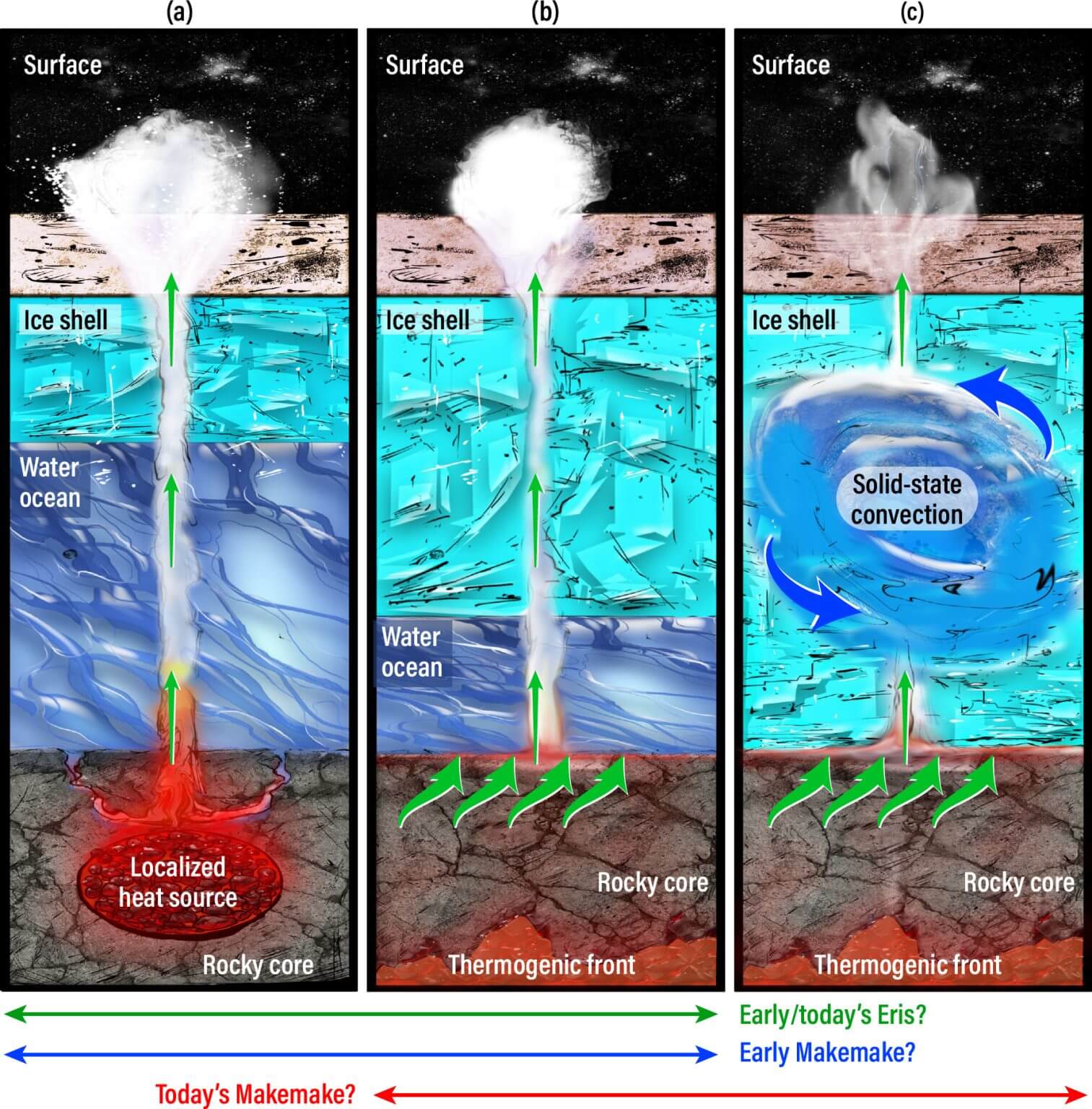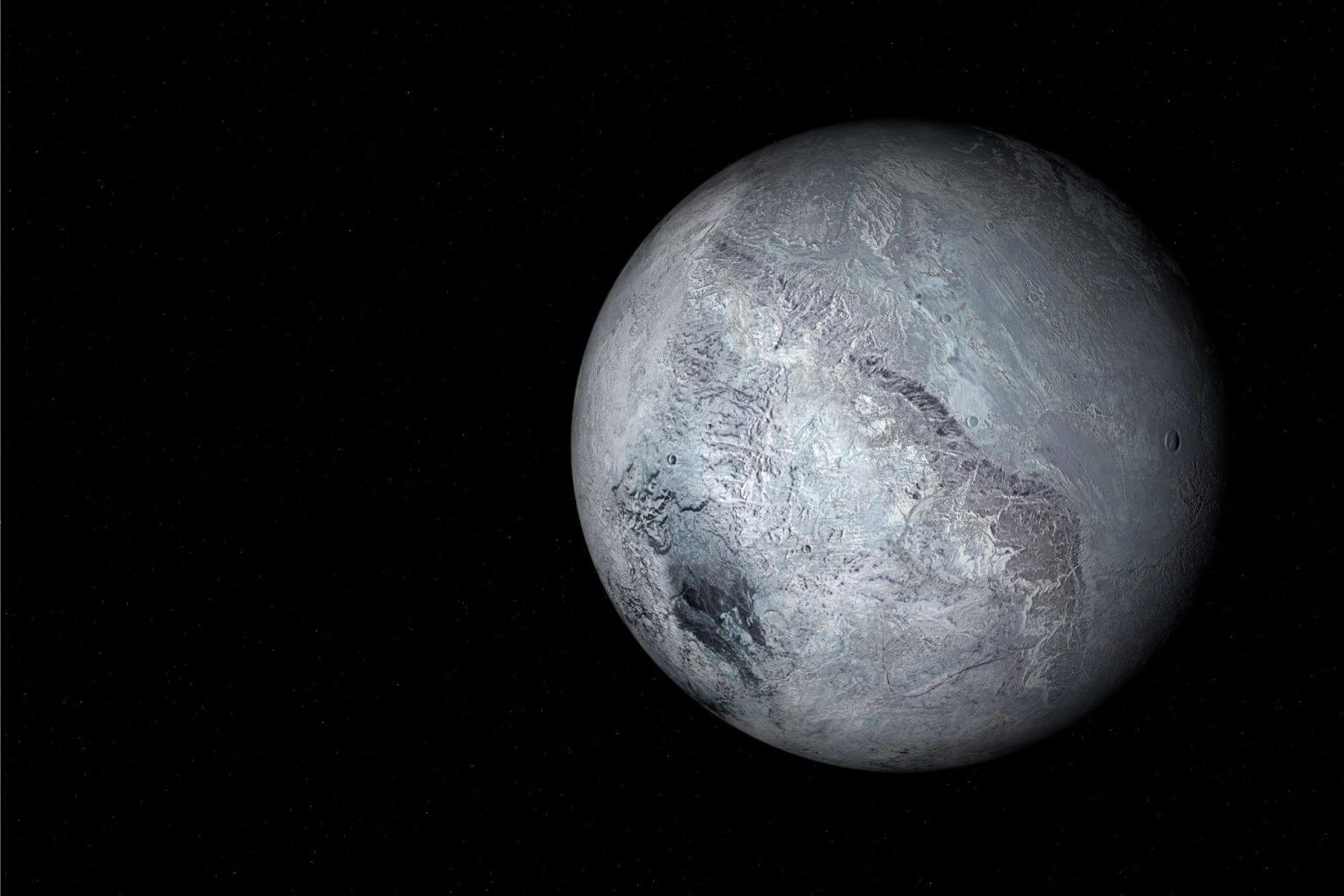The Webb telescope has observed what appear to be young methane deposits on the surface of Eris and Maki Maki

Evidence of internal geochemical activity on the icy dwarf planets Eris and Maki Maki suggests they may host subsurface oceans, challenging previous perceptions of these distant worlds as cold and inert. This discovery, made possible thanks to the James Webb Space Telescope, opens new avenues for research on the existence of life on planets and the dynamic nature of objects in the Kuiper belt.
Team led Southwest Research Institute discovered indications of hydrothermal or metamorphic processes within the icy dwarf planets Eris and Maki Maki, located in the Kuiper Belt. The presence of methane on their surface shows characteristics of hot or potentially hot geochemical activities in their rocky interior, distinctly different from the methane signatures found in comets.
"We see some interesting signs of warm times in cool places," said Dr. Christopher Glein of SwRI, an expert in planetary geochemistry and lead author of a paper on this discovery. "I came to this project thinking that Kuiper Belt Large Objects (KBOs) should have ancient surfaces inhabited by materials inherited from the primordial solar nebula, because their cold surfaces can preserve volatiles such as methane. Instead, the James Webb Space Telescope (JWST) surprised us! We found evidence indicating thermal processes producing methane emitted from Eris and Maki Maki.
Kuiper belt and the objects in it
The Kuiper Belt is a vast donut-shaped region of icy bodies beyond the orbit of Neptune at the edge of the Solar System. Eris and Maki Maki are similar in size to Pluto and its Saturn moon. These bodies were probably formed early in the history of our solar system, about 4.5 billion years ago. Away from the heat of our Sun, KBOs were believed to be cold, dead objects. Newly published work from JWST Research has made the first observations of isotopic molecules on the surface of Eris and Maki Maki. These isotopologues are molecules containing atoms with different numbers of neutrons. They provide useful data in understanding planetary evolution.

SwRI scientists used data from the James Webb Space Telescope to model the underground geothermal processes that could explain how methane eventually reached the surface of Eris Maki Maki, two dwarf planets in the distant Kuiper Belt. The figure suggests three possibilities, including the possibility that liquid water exists within these icy bodies at the edge of the solar system, away from the sun's heat. Credit: Southwest Research Institute
The JWST team measured the surface composition of the dwarf planets, specifically the ratio of deuterium (heavy hydrogen, D) to hydrogen (H) in methane. Deuterium is believed to have been created in the Big Bang, and hydrogen is the most common nucleus in the universe. The D/H ratio in a planetary body yields information about the origin, geologic history, and pathways of formation of hydrogen-containing compounds.
"The moderate D/H ratio we observed with JWST betrays the presence of primordial methane on an primordial surface. Primordial methane would have a much higher D/H ratio," said Glein. "Instead, the D/H ratio indicates geochemical sources for methane produced at depth. The D/H ratio is like a window. We can use it in a sense to peer beneath the surface. Our data indicate high temperatures in the rocky cores of these worlds, so that methane could be boiled. Molecular nitrogen (N2) can be produced as well, and we see it on Eris. "Hot cores can also indicate potential sources of liquid water beneath their icy surface."
Implications for life support and future exploration
Over the past two decades, scientists have learned that frozen worlds can be much more internally developed than once thought. Evidence of subsurface oceans has been found on several icy moons such as Saturn's moon Enceladus and Jupiter's moon Europa. Liquid water is one of the key elements in determining potential planetary habitability. The possibility that oceans of water exist within Eris and Maki Maki is something scientists are going to explore in the coming years. If one of them is habitable, it would become the most distant world in the solar system that could support life. Finding chemical indicators of internal driven processes takes them a step in this direction.
If Eris and Maki and Maki had or still have warm, or even warm, geochemistry in their rocky cores, cryo-volcanic processes could transport methane to the surface of these planets, perhaps in geologically recent times," said Dr. Will Grundy, an astronomer at the Lowell Observatory. , one of the authors of Glenn's paper and lead author of a companion paper. "We found a carbon isotope ratio (13C/12C) which suggests a relatively recent reawakening".)
This work is part of a paradigm shift in planetary science. It is increasingly recognized that cold, icy worlds may be warm beneath the surface. Models developed for this study also indicate the formation of geothermal gases on Saturn's moon Titan, which also has an abundance of methane. Furthermore, the occurrence of unexpected activity on Eris and Maki Maki highlights the importance of internal processes in shaping what we see on large KBOs and is consistent with the findings at Pluto.
"Following the New Horizons flyby through the Pluto system, and with this discovery, the Kuiper Belt is proving to be much more alive in terms of hosting dynamic worlds than we would have imagined," said Glein. "It's not too early to start thinking about sending a spacecraft to fly by one of these bodies to put the JWST data into a geological context. I believe we will be overwhelmed by the wonders that await us!"
For the scientific article: DOI: 10.1016/j.icarus.2024.115999
- The dwarf planet Eris is more massive than Pluto, according to a new study published by Eris Explorer
- Climate change also on Eris
- Astronomers: The tenth planet was discovered - apparently larger than Pluto and distant 97
- From now on they said Eris and not Xena * From now on he is also a dwarf planet
- Is the largest world in the solar system that doesn't yet have a name about to finally get one?

One response
A fourth possibility, the fall of asteroids, meteors during the time on the dwarf planets, as a result of which heat is created and methane emissions, can this be??